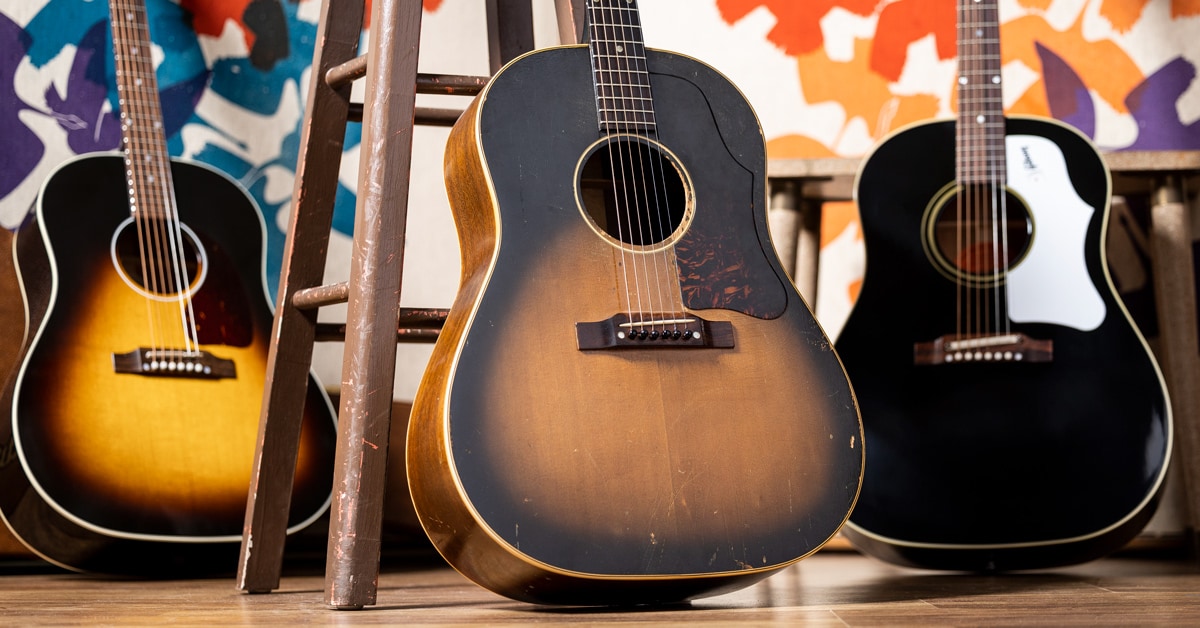It didn’t debut with fireworks, a parade or glitzy appointments.
Born in 1942, during the maelstrom of WWII, the Gibson J-45 replaced the low-cost J-35—another budget acoustic guitar manufactured during a different period of American upheaval, the Great Depression. Much like its predecessor, the J-45 exhibited stark and unassuming cosmetics—reportedly, Gibson chose a sunburst finish for the vast majority of models to obscure blemishes in the wood—and it was labeled by its own builder as merely a “workhorse guitar.”
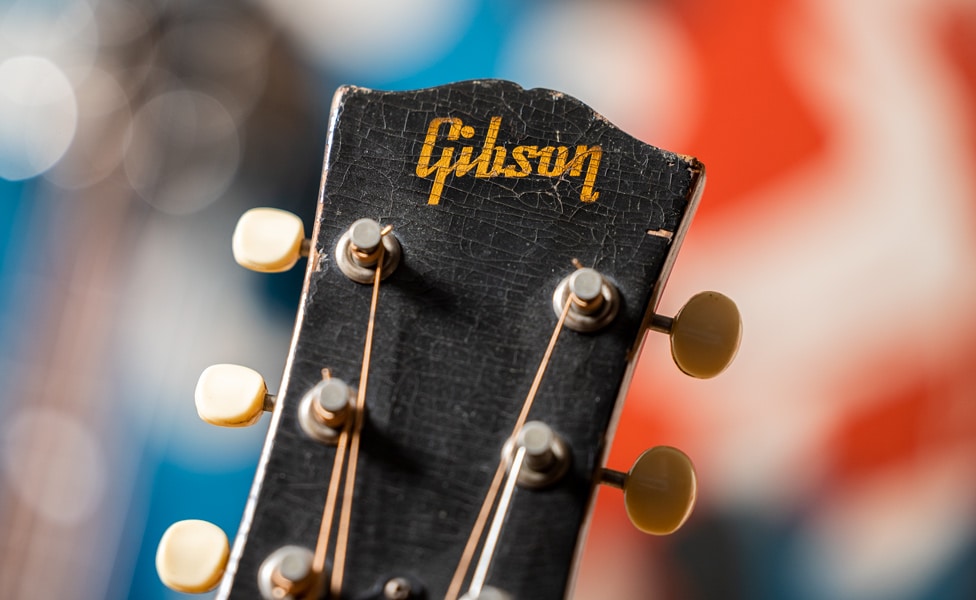
But, like the heroic choo-choo of another Depression-era touchstone, the 1930 version of The Little Engine That Could, the austere Gibson J-45 persevered, won fans and stepped into the limelight with players such as Woody Guthrie, Elvis Presley, Bob Dylan, Bruce Springsteen, Elvis Costello, Kacey Musgraves and scores of others. Projecting taut lows, clear yet contained mids and tranquil highs that caress and illuminate all styles of vocals, the “Little Guitar That Did” is now considered one of the most iconic flattops of all time.
Let’s take a deep dive into how and why a straightforward, no-frills workhorse—initially far less celebrated than the gorgeous archtops offered by Gibson and prized by jazzers—chugged its way to become the ultimate go-to guitar for songwriters, one of the most recorded acoustics in history and a steadfast stage instrument with a rugged heart and an enchanting tone.
Table of Contents
Gibson J-45 History
The Gibson J-45 Sound
Why the Gibson J-45 Is Easy to Play
Famous Gibson J-45 Players
A Guide to Current J-45 Models
The Best Gibson J-45 Acoustics
Gibson J-45 Standard Acoustic-Electric Guitar
Gibson J-45 Standard Rosewood Acoustic-Electric Guitar
Gibson J-45 Studio Walnut Acoustic-Electric Guitar
Gibson J-45 Studio Rosewood Acoustic-Electric Guitar
Gibson J-45 Standard 12-String Acoustic-Electric Guitar
Gibson 1942 Banner J-45 Acoustic Guitar
Gibson Murphy Lab 1942 Banner J-45 Light Aged Acoustic Guitar
Gibson J-45 '50s Faded Acoustic-Electric Guitar
Gibson '50s J-45 Original Acoustic-Electric Guitar
Gibson '60s J-45 Original Acoustic Guitar
Gibson J-45 Custom Ebony Acoustic-Electric Guitar
Gibson Slash J-45 Acoustic-Electric Guitar
Gibson Keb' Mo' 3.0 12-Fret J-45 Signature Acoustic-Electric Guitar
The Best Epiphone J-45 Acoustics
Epiphone Inspired by Gibson J-45 Acoustic-Electric Guitar
Epiphone Inspired by Gibson J-45 EC Acoustic-Electric Guitar
Epiphone 1942 Banner J-45 Acoustic-Electric Guitar
Epiphone J-45 Studio Acoustic Guitar
Epiphone J-45 EC Studio Acoustic-Electric Guitar
Gibson J-45 Studio Recording Tips
The Gibson J-45—From Low Cost to Legend
Gibson J-45 History
In an early foreshadowing of businesses “pivoting” during COVID, American manufacturers were rapidly challenged by supply and workforce limitations after the December 7, 1941 attack on Pearl Harbor propelled the nation into World War II. Suddenly, raw materials were desperately required for the war effort, and able-bodied men traded their tools and overalls for khakis and weapons.
Although production on the J-45 began in 1942, by 1944, Gibson General Manager Guy Hart had written U.S. Undersecretary of War Robert Patterson that the factory had been converted 100 percent from making instruments to crafting military goods. The footer on Gibson stationary was even changed to “Now 100% War Work—Air Corps, Navy, Army.”
But Hart wasn’t telling the whole truth.
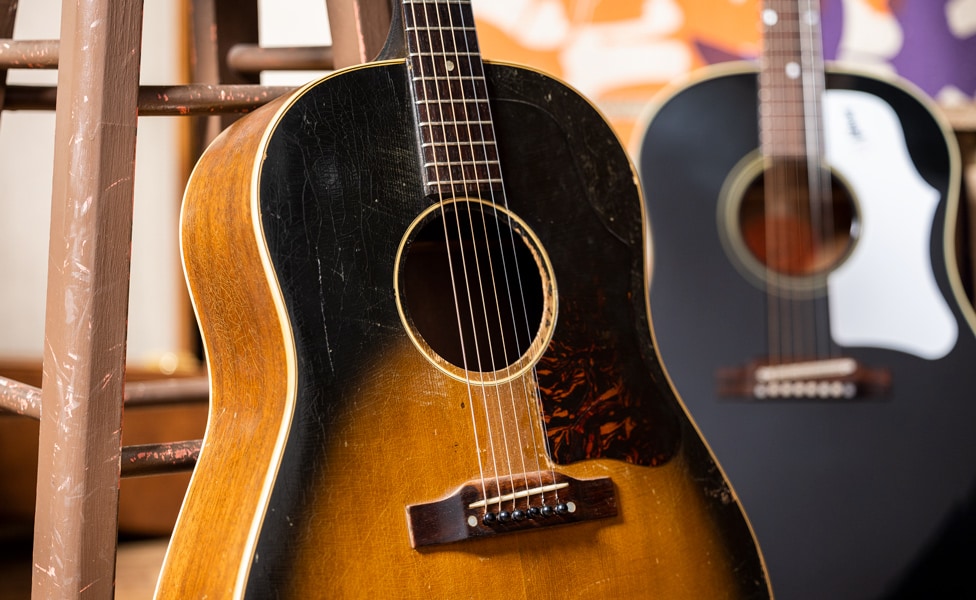
While Gibson earned a wartime “Excellence in Production” award for crafting wooden skids for CG-4A gliders and components for radar devices, the plant was also deploying a platoon of “Kalamazoo Girls” (named for the location of the factory and the women who replaced the male workers) to produce upwards of 25,000 “unauthorized” guitars. When the war came to an end, Gibson denied the factory had made any guitars at all.
It’s obvious why the company’s production during WWII needed to be “revised,” but the deception masked a glorious historical fact—that the initially untrained Kalamazoo Girls, bedeviled by wartime material shortages, ultimately overcame inconsistencies in manufacturing quality and sound. In fact, the wartime “Banner Gibsons” they built—produced from 1942–1945 and identified by a gold decal on the headstock that proclaimed “Only a Gibson is Good Enough”—are considered by some to be the most collectible Gibson acoustics. That said, as material availability was spotty during the war—and, as a result, some Banner J-45s sport different woods than others—the tone can vary significantly between these vintage instruments.
The 1942 J-45 may have been sparsely ornamented, but at $45—approximately $830 in today’s money—it wasn’t exactly a cheap and cheerful acquisition for all players. The slope-shouldered dreadnought was introduced with a spruce top and mahogany back and sides, but some wartime J-45s were constructed with mahogany tops and maple back and sides. (The Kalamazoo Girls had to occasionally go on the hunt for wood scraps in Gibson’s basement to complete a guitar.) Steel truss rods were also scarce—the military needed all the metal it could get for B-17 bombers, Tambor-class submarines, Sherman tanks and the like—and maple truss rods were common until after the war. The thick, rounded mahogany neck and rosewood fingerboard was a little hard to grasp for some players, but the added mass increased sustain. Despite the “baseball bat” neck, collectors often describe good 1942 versions of the J-45 to be lightly constructed and resonant.

Very early models had a teardrop pickguard made from firestripe-style celluloid, but the more common tortoiseshell celluloid was introduced in 1943. The teardrop disappeared in 1955, when a larger, more conventional pickguard made the scene—perhaps to protect a wide expanse of the top wood from rowdy, rockabilly strummers. That’s a joke, gang. A 20th fret was added in 1955, as well.
The mid ’50s also brought on a more solid—and somewhat heavier—construction approach, and a transformation from scalloped to unscalloped bracing, as well as a modified X shape. There was not a seismic change in overall tone, perhaps as the mass of the new brace was diminished to compensate for its weight.
Not surprisingly, the tumultuous ’60s (1962–1968) brought a virtual “happening” of changes to Gibson’s manufacturing of the J-45. The finish was brightened up from the dusky black or brown sunburst into a bright cherry hue that would look marvelous on the clothing in a swinging London boutique. An adjustable bridge was now standard, and the baseball bat neck was slimmed down to accommodate young players and anyone with dainty digits. In 1969, the J-45 become less slope shouldered and more square shouldered—to simplify production—and the scale was lengthened from 24-3/4" to 25-1/2".

One changeover was not part of a rock-and-roll dream: In the early 1960s, Gibson produced J-45s with plastic bridges. We could make a joke about hallucinogenic drugs and their effect on common sense, but we’ll just let this factoid sit quietly, as a “return to rosewood” occurred in the mid to late ’60s. Whew.
Movie audiences were divided in 1969, when George Lazenby took over the James Bond role from Sean Connery in On Her Majesty’s Secret Service. It wasn’t the only controversy that year. From 1969 until 1985, the Norlin Corporation owned Gibson, and the “Norlin era” is not well regarded by purists, who believe revenue suddenly became more important than quality. Whether as a result of that significant change in the business, or due to player preferences or other factors, sales of the J-45 declined, and the model was dismissed from the Gibson line in 1982. Happily, it bounced back—consider The Little Engine That Could reference at the beginning of this article—and the J-45 returned in 1984, along with some OG features, such as its rounded shoulders, teardrop pickguard and 24-3/4" scale. The J-45 may have experienced a long, strange trip throughout its existence, but according to a 2016 profile at gibson.com, it is the company’s best-selling acoustic ever.
The Gibson J-45 Sound
For an acoustic guitar to become as beloved as the J-45, it must inspire songs, caress voices and bathe notes in an almost unworldly glow. A guitar like the J-45 becomes much more than a tool. It’s an indispensable creative partner that challenges, amplifies and, ultimately, expresses and defines the artistry of moments—whether those moments are waiting for a song to emerge, intimately sharing music with one other person or commanding an audience of thousands.
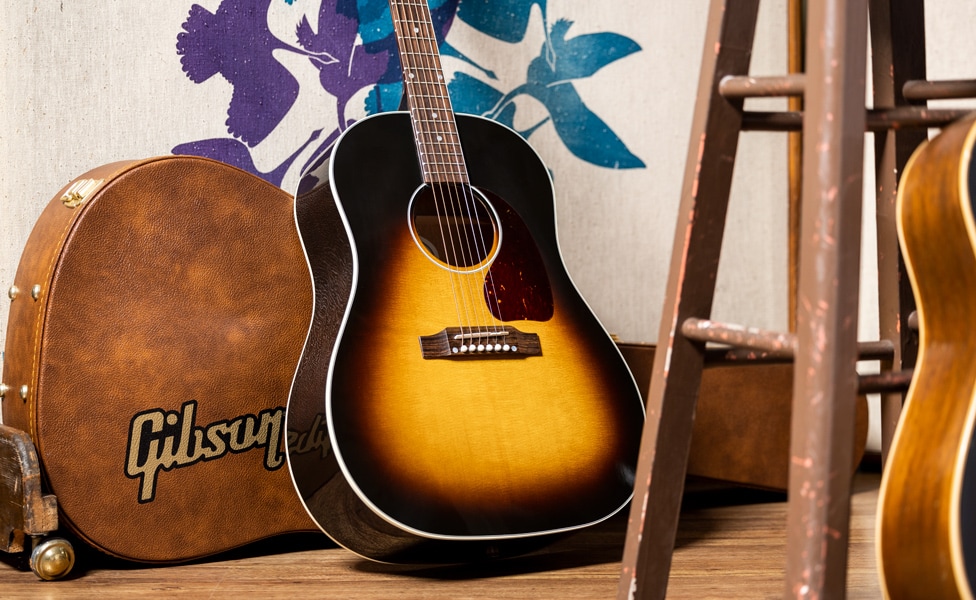
The J-45 typically wins over artists because its tone is so inviting. The sound is pleasant, but not timid. It produces warm, silky lows and bell-like highs, but the sound is never too boomy or too brittle. The critical midrange response is punchy and articulate without overwhelming the J-45’s well-balanced frequency spectrum. While the J-45 quite ably mirrors your attack to create subtle or forceful passages, it also refuses to let your dynamic technique compel the guitar to become unforgivably brash or too muddy. For example, you can strum hard or dig mercilessly into single-note lines, and the string-to-string definition is clear and eloquent. Even the sweet, ringing harmonics roused by a fierce attack blend harmoniously together to provide even dimension and smooth textures. It’s almost like you can’t force the J-45 to hate anything—a voice, a mix, a live ensemble or a musical style. The J-45 was originally envisioned as an affordable guitar for everyone, and its tone aspires to work itself beautifully into every artistic situation. The killer app for vocalists and singer-songwriters is that the J-45’s projection, while resolute, never aspires to wrestle the spotlight from your voice. Unlike some Martin dreadnoughts that are louder and bolder, a J-45 tends to hang back a bit and let the vocal sit atop the sparkle—a significant factor as to why the J-45 is one of the most recorded acoustic guitars in history.
Why the Gibson J-45 Is Easy to Play
Although it’s a dreadnought, the J-45’s sloped shoulders make it comfy and easy to play, and for players who like shredding and/or using brighter chord voicings, there’s slightly better access to the higher frets. The 24-3/4" scale also provides a relaxed playing experience compared to some longer-scale models. Unless you like the baseball bat neck that appeared on the original J-45, current models offer a slim, V-shaped neck that entices beginners and anyone who prefers a cozy, unrestricted pathway to the fingerboard.
Famous Gibson J-45 Players
So many players have wielded a J-45 that, together with Martin dreadnoughts and other Gibson models, it touches more than 80 years of acoustic music and musicmakers—from Lightnin’ Hopkins and Woody Guthrie to Kacey Musgraves and Jeff Tweedy. And the stories …

Guthrie famously painted “This Machine Kills Fascists” on his Gibson Southern Jumbo—an upscale J-45—and a few other of his favorite guitars. When Donovan traveled to India with the Beatles in 1968, he brought his J-45, and used it to teach John Lennon the claw-hammer fingerstyle technique. Lennon was so inspired by the lesson that he almost immediately wrote “Julia,” “Dear Prudence” and other songs for 1968’s The Beatles (aka the “White Album”). Buddy Holly dug his J-45 so much that he had a leather cover made for it bearing his name, the title of his debut single and the word “Texas.”
The J-45 has also graced just about every popular musical style. In addition to Lightnin’ Hopkins, many blues musicians gravitated to it, such as Elizabeth Cotten, Blind Gary Davis, Mississippi John Hurt and Keb’ Mo’. Rockers of all types are represented by players like Slash, David Gilmour, Britt Daniel, Ben Gibbard, Elvis Costello, James Mercer, Bruce Springsteen and “The King”—Elvis Presley. Troubadours and singer-songwriters have birthed thousands of songs using a J-45. Look at Bob Dylan, James Taylor, Aimee Mann, James Blunt, Gillian Welch and Luke Combs. And we’ve left hundreds of famous artists and thousands of working musicians off the list because it’s impossible to track the gazillions of songwriting and recording sessions where a J-45 has made an appearance.
A Guide to Current J-45 Models
Gibson’s “workhorse” acoustic has delighted so many players over the years—as well as appearing on countless albums, soundtracks and demo recordings—that the model has branched out into its own community. Today, Gibson and its affiliate brand, Epiphone, make J-45s for almost every style and budget. Let’s take a look at what’s available, how the models differ and help you find which J-45 might be the right one for you.
The Best Gibson J-45 Acoustics
Gibson J-45 Standard Acoustic-Electric Guitar
Why You Want One: With classic features and modern updates, it's still the famed workhorse that drove the folk music boom of the 1950s and ’60s.
Things to Consider:
- Same tonewoods as vintage pieces
- Updated SlimTaper neck for more comfortable playing
- LR Baggs VTC system for great acoustic sound with no “quack”
The Gibson J-45 Standard acoustic-electric is built with the same tonewoods that were selected for the 1942 original—a spruce top and mahogany back and sides. You can enjoy all of the sonic wonders and playability of a classic J-45, while getting your performance amped up and out there—at jam sessions, live shows and noisy busking locales—thanks to an L.R. Baggs VTC soundhole pickup/preamp.

Pictured: Gibson J-45 Standard Acoustic-Electric Guitar
Gibson J-45 Standard Rosewood Acoustic-Electric Guitar
Why You Want One: If you like your acoustic jumbo sound bigger and bolder, this rosewood back and sides version gets it done.
Things to Consider:
- Rosewood instead of mahogany back and sides for bigger, more complex sound
- More modern neck profile for increased playing comfort
- “Quack”-less amplified sound from LR Baggs VTC system
The Gibson J-45 Standard Rosewood is a great choice for players looking for high-end appointments with a different tone voice. It offers all of the playability you’d expect from a J-45, but the all-rosewood body and top offers a touch more bass response and overtone complexity. Whether on-stage or tracking in the studio, the on-board L.R. Baggs VTC soundhole pickup/preamp provides exceptional sonic performance.
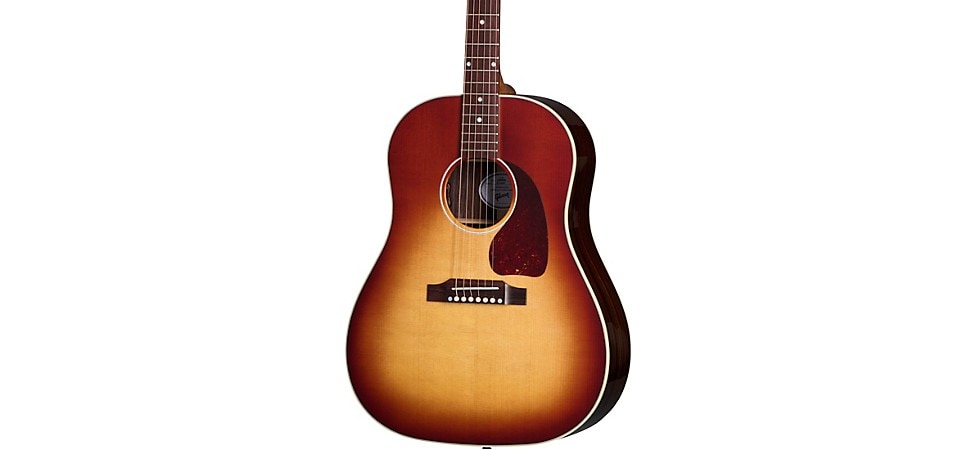
Pictured: Gibson J-45 Standard Rosewood Acoustic-Electric Guitar
Gibson J-45 Studio Walnut Acoustic-Electric Guitar
Why You Want One:This one is for the player who wants the glory of J-45 tone and style, but in a slightly plainer, more affordable package.
Things to Consider:
- Walnut back and sides reduce low-end response a bit
- Modern-profile utile (aka sipo mahogany) neck performs like traditional mahogany for less
- LR Baggs Element Bronze undersaddle piezo pickup for solid amplified performance
The J-45 Studio Walnut acoustic-electric guitar is a great option for those who want a bona fide Gibson J-45 but find the pricing of some models a bit rich. This is a stripped-down model, but it doesn’t give much away. The back and sides are walnut, which produce a tad less low-end body than the mahogany back and sides on more upscale J-45s, and the onboard pickup/preamp is a an L.R Baggs Element Bronze.
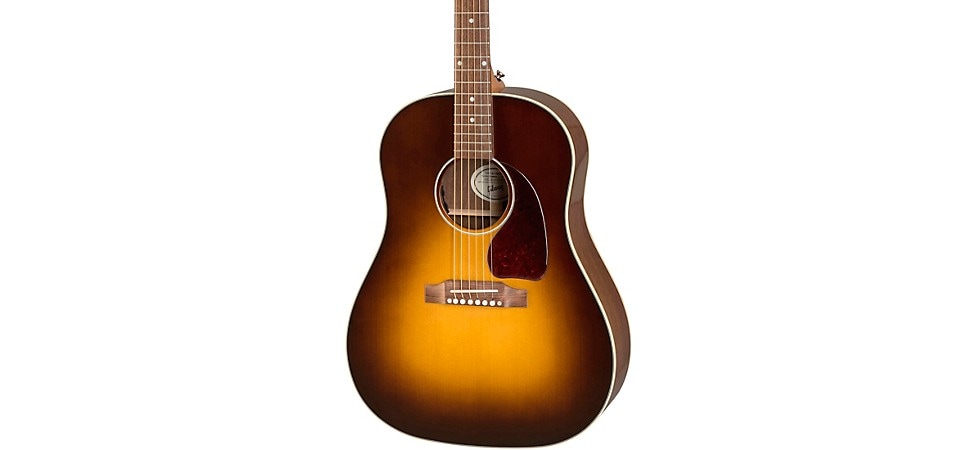
Pictured: Gibson J-45 Studio Walnut Acoustic-Electric Guitar
Gibson J-45 Studio Rosewood Acoustic-Electric Guitar
Why You Want One: This plainer, more accessible J-45 offers the bigger, bolder sound of rosewood back and sides.
Things to Consider:
- Big rosewood tone without the premium price
- Modern-profile utile (aka sipo mahogany) neck performs like traditional mahogany for less
- LR Baggs Element Bronze undersaddle piezo pickup for solid amplified performance
The J-45 Studio Rosewood acoustic-electric guitar has the same features and budget-friendly pricing as the Studio Walnut, but swaps the walnut back and sides for rosewood. The result is a slight price increase, but if you prefer a bit more low-end warmth, this is the model for you.
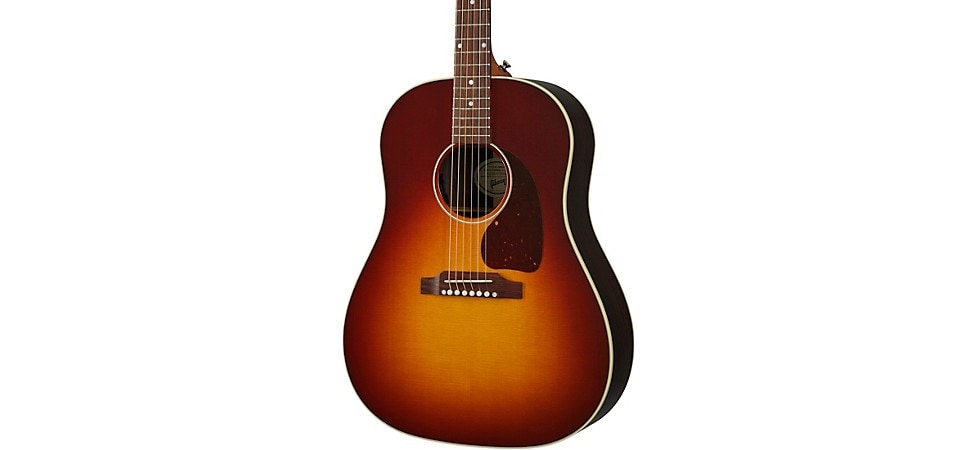
Pictured: Gibson J-45 Studio Rosewood Acoustic-Electric Guitar
Gibson J-45 Standard 12-String Acoustic-Electric Guitar
Why You Want One: Love the jangle and shimmer of a 12-string, and love the big sound of a J-45? Why not have both?
Things to Consider:
- Classic spruce top/mahogany back and sides combo for traditional tone
- Modern SlimTaper neck with rosewood fingerboard for easy playing
- LR Baggs Session VTC electronics for great acoustic sound with no “quack”
Want more J-45 tone? (Of course, you do.) The J-45 Standard 12-String acoustic-electric delivers the classic J-45 warmth and subtle punch, but with more jangle, sparkle and shimmer. An L.R. Baggs VTC pickup system is onboard for amplifying your rich ring.
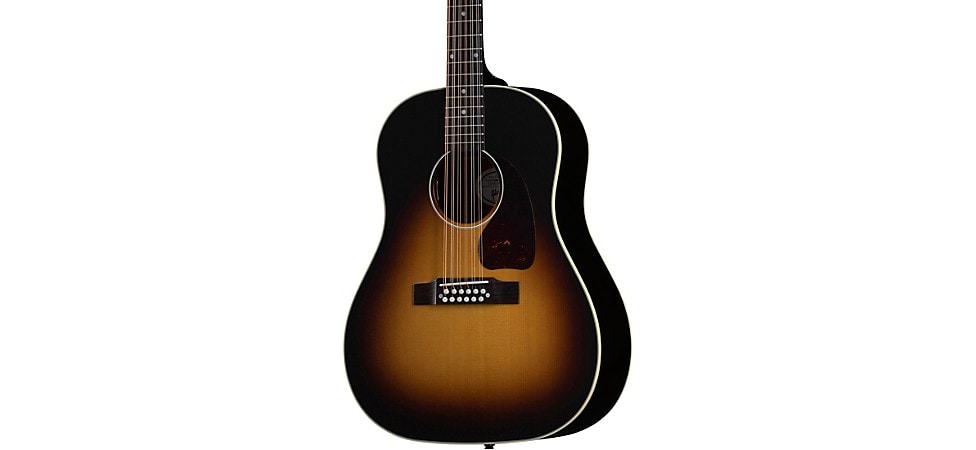
Pictured: Gibson J-45 Standard 12-String Acoustic-Electric Guitar
Gibson 1942 Banner J-45 Acoustic Guitar
Why You Want One: It's about as close as you can get to the original, but with an easier playing neck.
Things to Consider:
- Thermally aged spruce top delivers vintage tone without having to wait decades
- Modern V-shaped neck profile for more comfortable playing
- Traditional construction methods include hot hide glue, handcarved bracing and vintage bone nut and saddle
Take Mr. Peabody’s Wayback Machine to the wartime era of the Kalamazoo Girls with this recasting of the original J-45 acoustic. Playability is enhanced with a modern and slim V-shaped neck, rather than the baseball bat shape of the 1942 model.
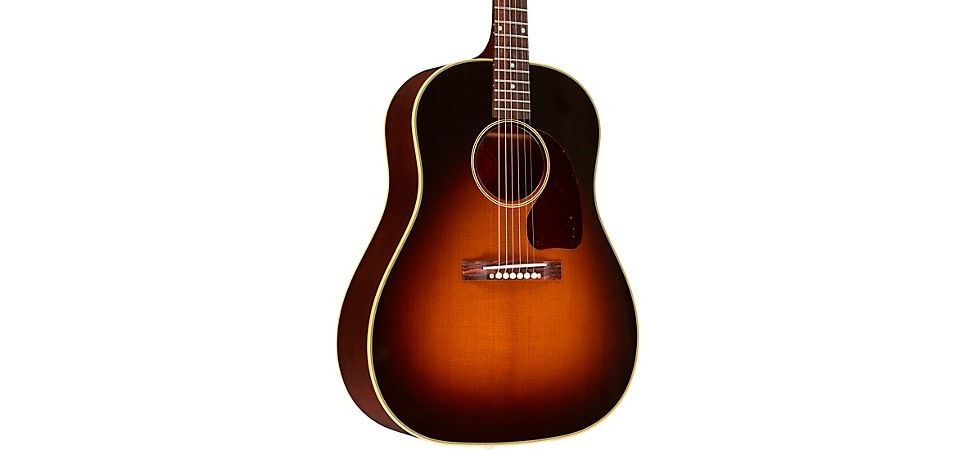
Pictured: Gibson 1942 Banner J-45 Acoustic Guitar
Gibson Murphy Lab 1942 Banner J-45 Light Aged Acoustic Guitar
Why You Want One: Aside from the sheer coolness of Murphy Lab finish treatments, this is probably as close as you can get to owning an original.
Things to Consider:
- Thermally aged Adirondack red spruce top grabs vintage tone without having to wait 75 years
- Traditional hot hide glue construction
- Aged bone nut and saddle guarantees lively, authentic sound
If you've ever lusted for a "holy grail" acoustic, this stunning recreation of an original 1942 Gibson J-45 can satisfy that urge. It not only looks and feels the part, but it sounds it, too, thanks to the magic worked by the team at Murphy Lab.

Pictured: Gibson Murphy Lab 1942 Banner J-45 Light Aged Acoustic Guitar
Gibson J-45 ’50s Faded Acoustic-Electric Guitar
Why You Want One: Get that big J-45 tone, with just enough fade on the finish to instantly make it an old friend.
Things to Consider:
- Traditional spruce/mahogany tonewood combination for big-bodied tone
- 1930s-style handscalloped bracing for increased projection
- LR Baggs Session VTC electronics for great acoustic sound with no “quack”
The J-45 ’50s Faded acoustic-electric has a striking, vintage-vibe finish, as well as the larger pickguard and 20th fret the Gibson factory added to the guitar in the Truman-Eisenhower era. A more modern update is the L.R. Baggs VTC pickup/preamp.
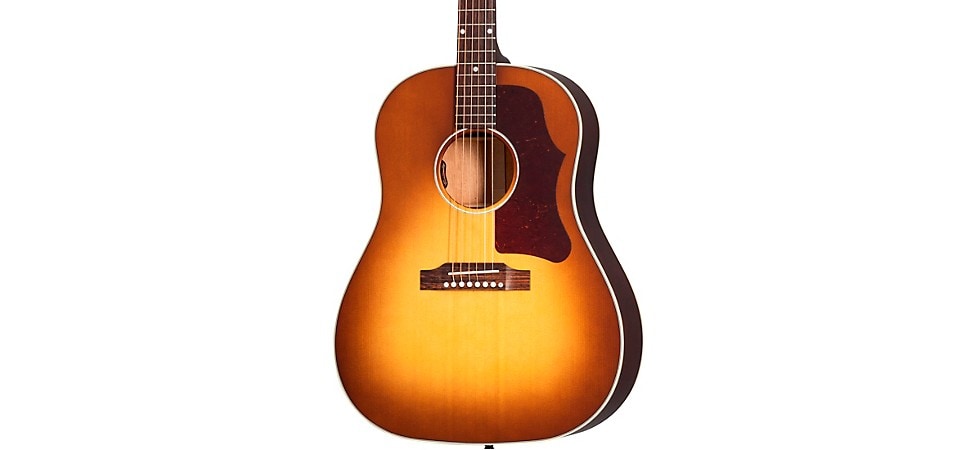
Pictured: Gibson J-45 ’50s Faded Acoustic-Electric Guitar
Gibson ’50s J-45 Original Acoustic-Electric Guitar
Why You Want One: In your heart of hearts, are you a 1950s aspiring country-western singer who just got a record company advance to buy a new guitar? This is the one you'd pick up and love!
Things to Consider:
- Traditional spruce/mahogany tonewood combination for big-bodied tone
- 1930s-style hand-scalloped bracing for increased projection
- LR Baggs Session VTC electronics for great acoustic sound with no "quack"
The J-45 ’50s Original is a stunner, but if you want a smokier, even more vintage look, the J-45 ’50s Original acoustic-electric—with its slightly antiqued tobacco sunburst—is likely your jam. The L.R. Baggs VTC pickup/preamp also appears on this model.
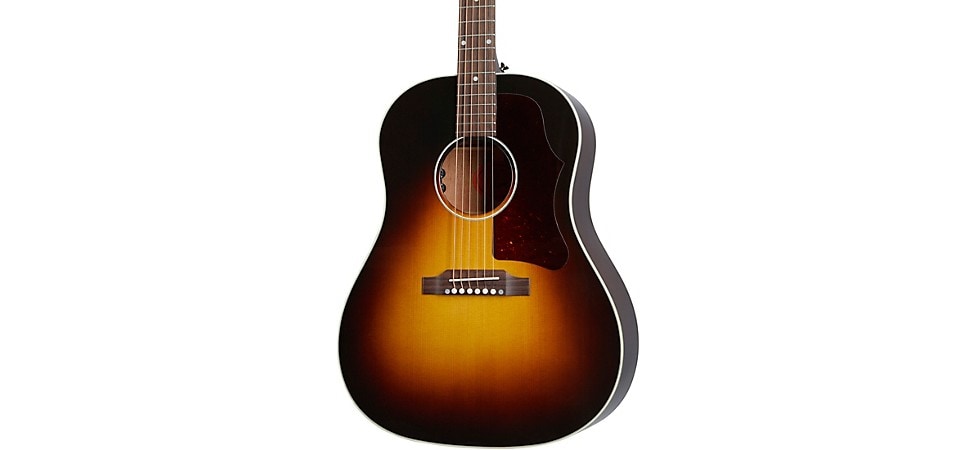
Pictured: Gibson '50s J-45 Original Acoustic-Electric Guitar
Gibson ’60s J-45 Original Guitar
Why You Want One: If you dig ’60s vibe and sound, this J-45 looks and sounds the part.
Things to Consider:
- Period touches include large white pickguard and adjustable bridge saddle
- Carefully selected spruce tops and mahogany back and sides for an articulate, mid-forward tone
- Handscalloped X-bracing for lively response
As we remarked in the J-45 History part of this article, the 1960s were a time of cultural change, and the transformations were reflected in fashion, music and guitarcraft, among other things. The ’60s J-45 Original Acoustic Guitar evokes folkie coffee houses and counter-culture jam sessions with its large white pickguard punctuating the guitar’s ebony finish.
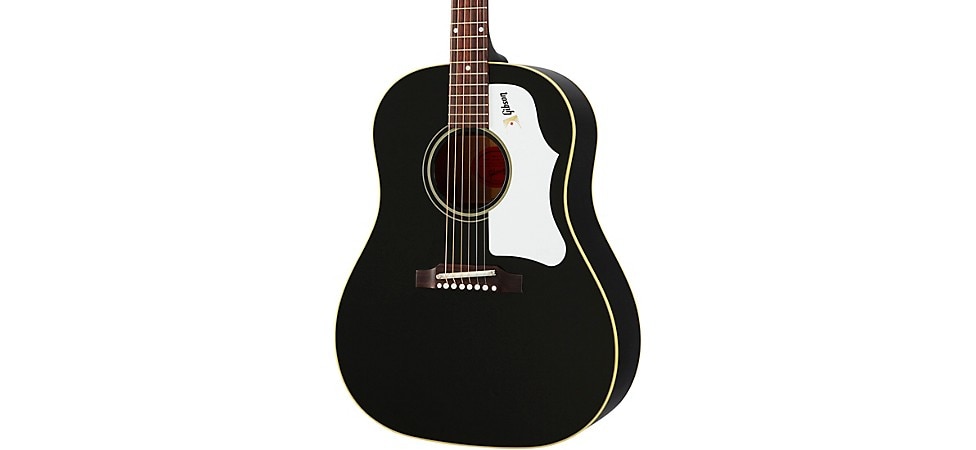
Pictured: Gibson '60s J-45 Original Acoustic Guitar
Gibson J-45 Custom Ebony Acoustic-Electric Guitar
Why You Want It: This J-45 comes off as a cool cross between a classic acoustic and a Les Paul Custom, loaded with tons of cool attitude.
Things to Consider:
- Classic combination of Sitka spruce top and rosewood back and sides with bound ebony fingerboard
- LR Baggs Session VTC electronics for great acoustic sound with no “quack”
- Cutaway for easy upper-fret access
Sometimes it’s content, sometimes it’s style, but it’s great when a guitar has both. With Gibson’s 1930s bracing style paired with an updated neck and body shape, this J-45 Custom Ebony acoustic-electric is definitely a future classic in the offing.

Pictured: Gibson J-45 Custom Ebony Acoustic-Electric Guitar
Gibson Slash J-45 Acoustic-Electric Guitar
Why You Want One: If you're looking for a great balance of vintage and modern, this signature J-45 should be your jam.
Things to Consider:
- Vintage C neck profile gives true vintage feel
- 16"-radius rosewood fingerboard for fast fretting
- LR Baggs Session VTC electronics delivers “quack”-less amplified sound
For his signature Slash J-45 acoustic-electric guitar, the top-hatted rocker balanced modern appointments with the features of vintage models in his massive guitar collection. For example, the old-school finish and custom C-neck profile harken back to wartime J-45s, while the Grover Rotomatic tuners, 16" fingerboard radius and L.R. Baggs VTC pickup/preamp speak to the now.
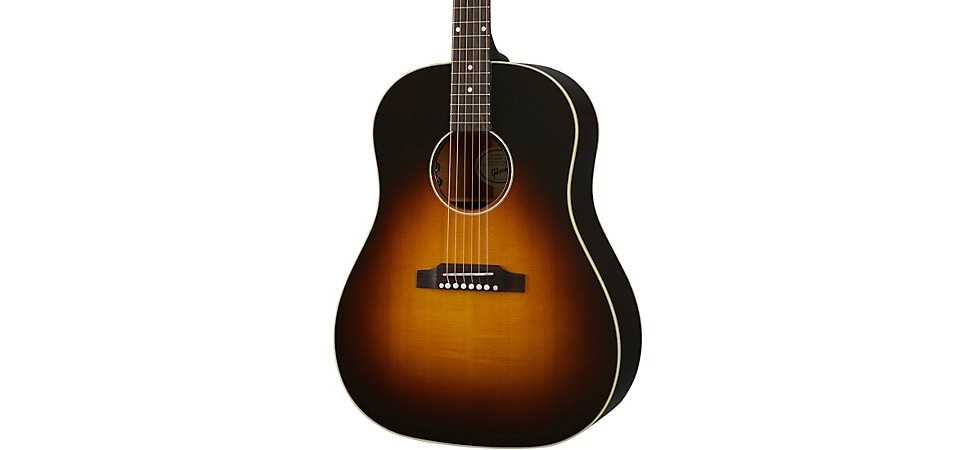
Pictured: Gibson Slash J-45 Acoustic-Electric Guitar
Gibson Keb' Mo' 3.0 12-Fret J-45 Signature Acoustic-Electric Guitar
Why You Want One: This one's for the player who loves traditional blues styles.
Things to Consider:
- Thermally aged Sitka spruce top delivers the tone of a decades-old instrument
- Signature Keb' Mo' neck profile with 12th-fret neck joint adds resonance while making for easier playing
- LR Baggs Session VTC electronics for great acoustic sound with no “quack”
For his Keb’ Mo’ J-45 Signature model, the five-time Grammy winner and blues musicologist choose the added tonal resonance and playing comfort of a guitar where the body joins the neck at the 12th fret. This vintage-finished J-45 also features a custom Keb’ Mo’ neck shape and L.R. Baggs electronics.

Pictured: Gibson Keb' Mo' 3.0 12-Fret J-45 Signature Acoustic-Electric Guitar
The Best Epiphone J-45 Acoustics
Epiphone Inspired by Gibson J-45 Acoustic-Electric Guitar
Why You Want One: If a J-45 is your aspirational guitar, but your budget’s not quite there yet, this Epiphone will calm the urge.
Things to Consider:
- Solid Sitka spruce top and solid mahogany back and sides for classic J-45 tone
- Vintage-style “C” neck profile delivers vintage feel
- Fishman Sonicore pickup system with sound hole preamp and controls
The Epiphone Inspired by Gibson J-45 is an affordable homage to the 1942 model (rounded neck shape, spruce top, mahogany back and sides, and vintage tuners), the ’50s version (large pickguard) and today’s acoustic-electric guitars (Fishman Sonicore pickup system).
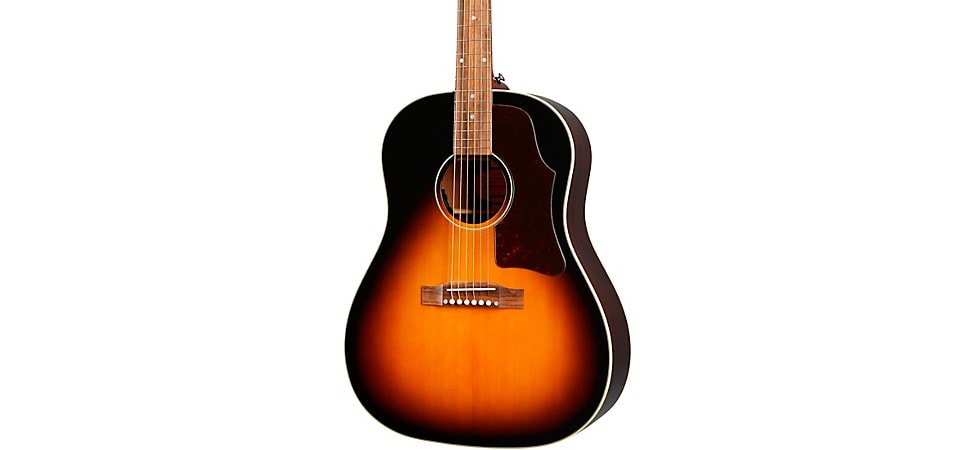
Pictured: Epiphone Inspired by Gibson J-45 Acoustic-Electric Guitar
Epiphone Inspired by Gibson J-45 EC Acoustic-Electric Guitar
Why You Want One: Want that J-45 with better upper-fret access? Get it here.
Things to Consider:
- Solid Sitka spruce top and solid mahogany back and sides for classic J-45 tone
- Cutaway for easy access to the wheedly-wheedly bits
- Fishman Sonicore pickup system with sound hole preamp and controls
The venerated J-45 is now clocking a trio of body styles—the original slope shoulder, the ’60s square shoulder and, now, a cutaway version for easy access to the high frets. Also part of the Epiphone Inspired by Gibson J-45 EC acoustic-electric guitar package is a Fishman Sonicore pickup with a Fishman Presys II preamp.
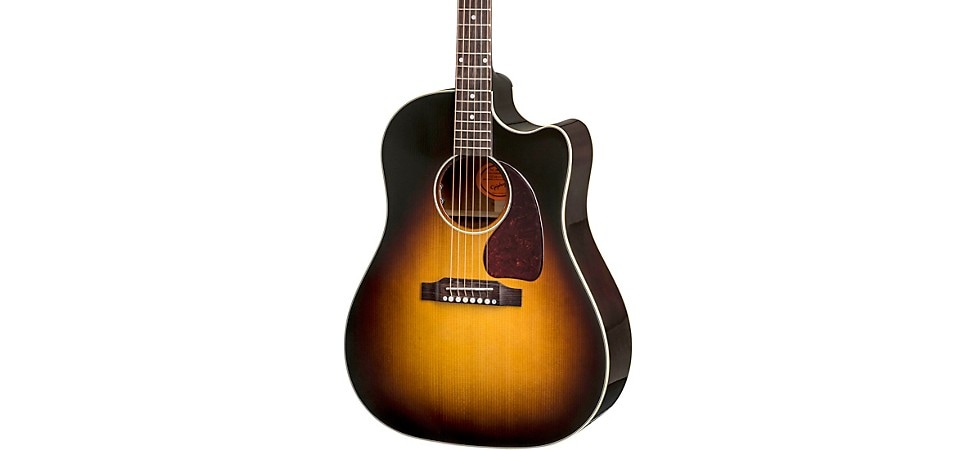
Pictured: Epiphone Inspired by Gibson J-45 EC Acoustic-Electric Guitar
Epiphone 1942 Banner J-45 Acoustic-Electric Guitar
Why You Want One: This J-45 delivers massive bang for the buck, with deep vintage vibe and sound.
Things to Consider:
- Thermally aged spruce top delivers vintage tone without having to wait decades
- Modern "V" neck profile for increased playing comfort
- LR Baggs Session VTC electronics for great acoustic sound with no “quack”
Designed in partnership with the Gibson Custom team, the Epiphone 1942 Banner J-45 is a remarkable recreation of the legendary “Workhorse” model. The ’42 Banner J-45 delivers all of the warmth you'd expect from a vintage instrument thanks to its thermally aged, solid red spruce top and solid mahogany back and sides. The one-piece mahogany V-shaped neck with laurel fingerboard is topped off with the iconic Gibson “open book” headstock, vintage-style Epiphone logo and “Epiphone Inspired by Gibson" banner. An L.R. Baggs VTC pickup system, the same found on their Gibson models, delivers stage-ready direct sound.
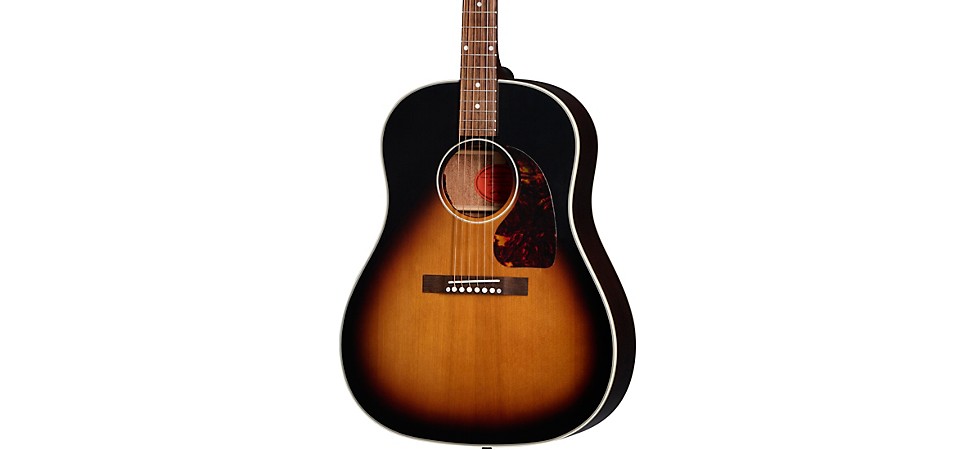
Pictured: Epiphone 1942 Banner J-45 Acoustic-Electric Guitar
Epiphone J-45 Studio Acoustic Guitar
Why You Want One: The looks and vibe of a J-45 at an entry-level price? Who wouldn’t?
Things to Consider:
- Solid Sitka spruce top in classic pairing with mahogany back and sides
- Mahogany neck and rosewood bridge and fingerboard
- Iconic slope-shoulder body profile
Offering a fair piece of J-45 vibe at an almost astounding under-$300 price, the Epiphone J-45 Studio acoustic guitar delivers the classic tonewoods, along with the ’60s-era, 25-1/2" scale.
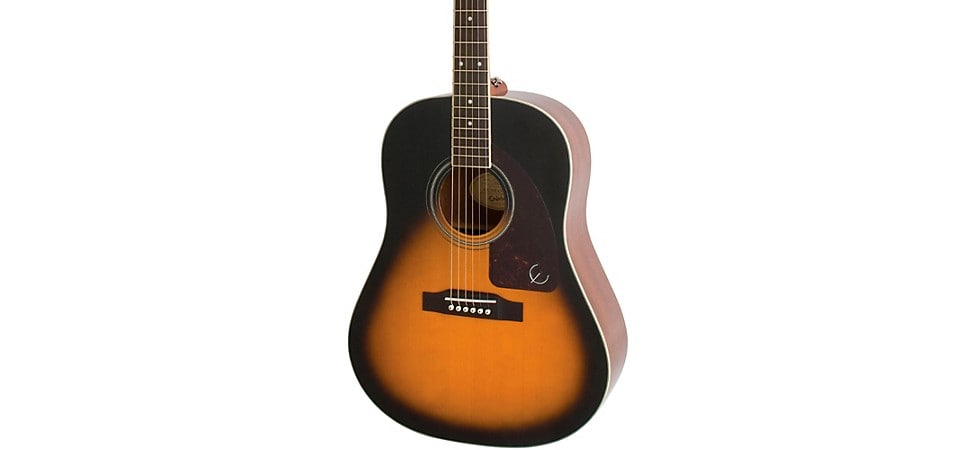
Pictured: Epiphone J-45 Studio Acoustic Guitar
Epiphone J-45 EC Studio Acoustic-Electric Guitar
Why You Want One: If you want to take it to the stage on a budget, this J-45 gets you there fast.
Things to Consider:
- Solid spruce top plus mahogany back and sides for classic tonewood combination
- SlimTaper neck for easy playing
- Fishman electronics for great amplified sound
The Epiphone J-45 EC Studio is perhaps a more live-performance focused model than the Epiphone J-45 Studio. The EC delivers a SlimTaper, C-shape neck and a Fishman Sonicore pickup/Presys II preamp combo for taking the J-45 sound to the stage.

Pictured: Epiphone J-45 EC Studio Acoustic-Electric Guitar
Gibson J-45 Studio Recording Tips
Many players use the studio as a creative tool where anything goes, and that’s wonderful. If you want some tips for furthering your experimentation with acoustic guitar sounds, check out our articles on The Best Microphones for Recording Acoustic Guitar and How to Record Acoustic Guitar. However, these recording tips are more focused on not messing with perfection, as an organic and natural J-45 tone can sometimes be exactly what you want.

One of the ways to ensure a predominantly transparent sound that honors the tone of a good J-45 is to record it with a ribbon microphone. For an organic perspective, try positioning the ribbon mic in front of the J-45 at a distance of one to two feet, and pointing at the middle of the soundhole. If there’s too much bass or low-midrange content for your taste, angle the microphone a tad off-axis to the soundhole, or even try moving the mic back a few inches. You can also angle the ribbon near the 12th fret if you desire a bit more sparkle. As we’re striving to stay out of the J-45’s way and pretty much let it do its natural, balanced tone thing, consider using one mic to capture the sound, rather than stereo miking. True, using two ribbon mics—one positioned for treble frequencies and the other for bass—will record a wider tonal spectrum that can be blended to mono or panned for extreme stereo, but you may not need to go to any additional trouble. The unadulterated, mono sound of the J-45 is a thing of beauty, and it typically fits right into any mix—no matter how sparse or dense the tracks might be. It goes without saying—but we’ll say it—that you should think twice before processing a J-45 with excessive EQ and/or compression. Critically assess the source sound before tinkering with knobs and plug-ins, because the “naked” J-45 is likely the perfect tone for your mix.
For a tutorial on how ribbon mics do what they do, check out How Ribbon Mics Work. If you want some recommendations on ribbons that can really bring out the organic sonics of a J-45, see our list of top ribbon mics in How to Choose the Best Microphone.
The Gibson J-45—From Low Cost to Legend
Ever since Gibson called the J-45 a “workhorse guitar” back in 1942, it has been put to work. It’s impact on artists and songs is so broad and massive as to be practically incalculable. Not a bad heritage for something that was initially thought of as a basic tool—something not unlike a screwdriver or a hammer. The renowned vintage-guitar dealer Norman Harris once put it quite simply: “The J-45 fits in with the human voice, and it’s very durable. You can beat the hell out of them.”
And yet, within the J-45’s utensil-like, perhaps not-so-mysterious tone and playability lies the key to so much music and joy. That almost seems less a definition of “workhorse” and more a description of “magic.”










